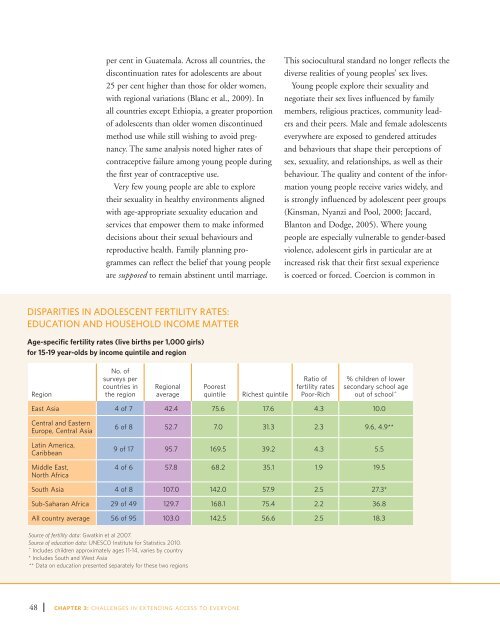State of World Population 2012 - Country Page List - UNFPA
State of World Population 2012 - Country Page List - UNFPA
State of World Population 2012 - Country Page List - UNFPA
You also want an ePaper? Increase the reach of your titles
YUMPU automatically turns print PDFs into web optimized ePapers that Google loves.
per cent in Guatemala. Across all countries, the<br />
discontinuation rates for adolescents are about<br />
25 per cent higher than those for older women,<br />
with regional variations (Blanc et al., 2009). In<br />
all countries except Ethiopia, a greater proportion<br />
<strong>of</strong> adolescents than older women discontinued<br />
method use while still wishing to avoid pregnancy.<br />
The same analysis noted higher rates <strong>of</strong><br />
contraceptive failure among young people during<br />
the first year <strong>of</strong> contraceptive use.<br />
Very few young people are able to explore<br />
their sexuality in healthy environments aligned<br />
with age-appropriate sexuality education and<br />
services that empower them to make informed<br />
decisions about their sexual behaviours and<br />
reproductive health. Family planning programmes<br />
can reflect the belief that young people<br />
are supposed to remain abstinent until marriage.<br />
This sociocultural standard no longer reflects the<br />
diverse realities <strong>of</strong> young peoples’ sex lives.<br />
Young people explore their sexuality and<br />
negotiate their sex lives influenced by family<br />
members, religious practices, community leaders<br />
and their peers. Male and female adolescents<br />
everywhere are exposed to gendered attitudes<br />
and behaviours that shape their perceptions <strong>of</strong><br />
sex, sexuality, and relationships, as well as their<br />
behaviour. The quality and content <strong>of</strong> the information<br />
young people receive varies widely, and<br />
is strongly influenced by adolescent peer groups<br />
(Kinsman, Nyanzi and Pool, 2000; Jaccard,<br />
Blanton and Dodge, 2005). Where young<br />
people are especially vulnerable to gender-based<br />
violence, adolescent girls in particular are at<br />
increased risk that their first sexual experience<br />
is coerced or forced. Coercion is common in<br />
Disparities in adolescent fertility rates:<br />
Education and household income matter<br />
Age-specific fertility rates (live births per 1,000 girls)<br />
for 15-19 year-olds by income quintile and region<br />
Region<br />
No. <strong>of</strong><br />
surveys per<br />
countries in<br />
the region<br />
Regional<br />
average<br />
Poorest<br />
quintile<br />
Richest quintile<br />
Ratio <strong>of</strong><br />
fertility rates<br />
Poor-Rich<br />
% children <strong>of</strong> lower<br />
secondary school age<br />
out <strong>of</strong> school^<br />
East Asia 4 <strong>of</strong> 7 42.4 75.6 17.6 4.3 10.0<br />
Central and Eastern<br />
Europe, Central Asia<br />
Latin America,<br />
Caribbean<br />
Middle East,<br />
North Africa<br />
6 <strong>of</strong> 8 52.7 7.0 31.3 2.3 9.6, 4.9**<br />
9 <strong>of</strong> 17 95.7 169.5 39.2 4.3 5.5<br />
4 <strong>of</strong> 6 57.8 68.2 35.1 1.9 19.5<br />
South Asia 4 <strong>of</strong> 8 107.0 142.0 57.9 2.5 27.3*<br />
Sub-Saharan Africa 29 <strong>of</strong> 49 129.7 168.1 75.4 2.2 36.8<br />
All country average 56 <strong>of</strong> 95 103.0 142.5 56.6 2.5 18.3<br />
Source <strong>of</strong> fertility data: Gwatkin et al 2007.<br />
Source <strong>of</strong> education data: UNESCO Institute for Statistics 2010.<br />
^ Includes children approximately ages 11-14, varies by country<br />
* Includes South and West Asia<br />
** Data on education presented separately for these two regions<br />
48 CHAPTER 3: CHALLENGES IN EXTENDING ACCESS TO EVERYONE
















